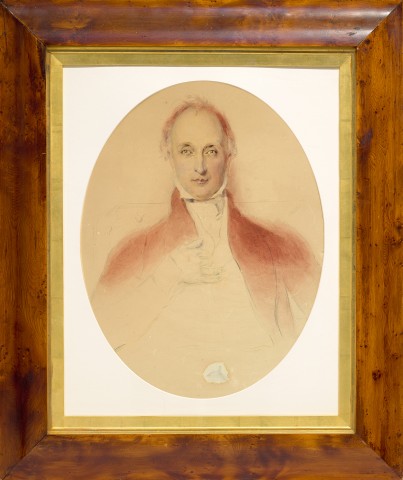EDWARD LORD, R.M., c.1838 - 39 or 1846
THOMAS WAINEWRIGHT
pencil and watercolour wash on paper
45.5 x 35.5 cm
Crosby family, Tasmania
Thence by descent
Kathleen Dodgson, née Crosby, Tasmania
Thence by descent
Richard Dodgson, Tasmania
Thence by descent
Private collection, Tasmania, daughter of the above
Crossland, R., Wainewright in Tasmania, Oxford University Press, Melbourne, 1954, pl. 3 (illus.), n.p.
E. Lord Esq. R M, 1846, pencil and watercolour on paper, 48.5 x 38.0 cm, in the collection of Allport Library and Museum of Fine Arts, State Library of Tasmania, Hobart
Thomas Griffiths Wainewright is without doubt one of the finest portraitists to have worked in the Australian colonies in the mid nineteenth century. His elegant portraits of well-to-do Hobart residents demonstrate his assured draughtsmanship and close observation of character. His distinctive elongation of facial features combined current aesthetic ideals with his intimate knowledge of European art, from Classical art to Mannerism to Romanticism. Wainewright came from notably different circumstances to those of most convicts, with his crime self, rather than societally, induced. As a child, he had received a thorough classical education and was introduced to English intellectual circles through his grandfather, Ralph Griffiths, a successful publisher and literary editor. By his twenties, Wainewright was writing erudite articles and art reviews for British journals. He was also exhibiting at the Royal Academy, following periods of training with leading portraitists John Linnell and Thomas Phillips, and associating with artists including Henry Fuseli and William Blake. However, Wainewright’s indulgent London lifestyle soon outstripped his generous income, and he fraudulently gained access to funds in his grandfather’s estate. It was believed that he also poisoned his uncle, mother-in-law and sister-in-law who all died suddenly – to Wainewright and his wife’s financial benefit. While living under a pseudonym in France, Wainewright’s forgeries came to light and in 1837, he was sentenced to life transportation.
For the first two years of his term, Wainewright laboured on a road gang, housed in the Hobart Penitentiary, ‘without friends, good name (the breath of life) or art’, as he put it.1 Poor health proved advantageous when he was transferred to the Colonial Hospital where he befriended like-minded doctors. Their support and introductions, plus his eloquence and artistry, enabled him to improve his circumstances. Although he did not receive his Ticket of leave until 1844, from the late 1830s Wainewright captured the features of many of the families of Hobart’s developing settler society in fluid pencil lines and subtly applied watercolour.
One such person was Edward Lord (1781 – 1859), who came to Australia in 1803 as a well-connected young officer of the marines, participant in the British attempt to colonise Boon Wurrung Country, at Sorrento, Port Phillip. Unsuccessful, the contingent of marines and convicts, under the command of David Collins, was directed to the banks of the Derwent River in Van Diemen’s Land, where they founded Hobart Town on Nipaluna at the base of Kunanyi / Mt Wellington in 1804. There Lord had built the first private house, rose to be second-in-command and briefly served as acting Lieutenant-Governor upon Collin’s death in 1810.2 Lord developed close and advantageous friendships with subsequent Lieutenant-Governors, Davey and Sorrell, although Governor Macquarie in Sydney described him as a ‘dangerous and troublesome man… vindictive and implacable.’3
In 1808, Lord married his convict partner, Maria Risely (c. 1780-1859), who proved herself an intelligent and energetic businesswoman, establishing a store and supplying government requirements. Through their government connections, pastoral handouts and mercantile investments, the couple controlled an extraordinary third of the colony’s wealth by 1820.4 Significantly, the Lords’ house and warehouse, Ingle Hall (built 1811 – 14) is Hobart’s earliest surviving residence, and second oldest building.5 During the 1810s and 1820s, Lord travelled to London multiple times, transporting goods in either direction, with fluctuating fortune, before he settled in Kent, England. He returned only twice in subsequent years, in 1838 – 39 and again, for the seventh and final time, in 1846 – 47.
Despite having access to leading portraitists in England, it was in Hobart that Lord decided to have his portrait painted. Wainewright’s well-known portrait in the Allport Library, Hobart, of his patrician features relaxing in a high-backed wooden chair, was painted during his last visit, shortly before the artist suffered a debilitating stroke in late 1846. This portrait of Lord, sitting upright with outlined hand resting calmly on his upper chest, may have been drawn during his previous visit, as until now it has remained with descendants of Maria’s first daughter (Lord’s step-daughter) Caroline, who died in 1840.6 This date accords with the recent suggestion by Wainewright specialist, Jane Stewart, that an oil painting depicting Lord in a black cravat may be by Wainewright, painted during his 1838 – 39 visit. If correct, this is the first oil painting by Wainewright made in Tasmania to be identified.7
While showing the fading of pigments typically seen in his watercolours, the present portrait offers a superb example of Wainewright’s sensitive and skilful execution, depicting an individual notable – even notorious – in Tasmania’s first decades of occupation.
1. See Wainewright’s Petition for a Ticket of Leave, 1844, State Library of New South Wales, reproduced in Stewart, J., Thomas Griffiths Wainewright: Paradise Lost, Tasmanian Museum and Gallery, Hobart, 2021, pp. 155 – 57
2. See unknown artist, The first house erected in Hobart Town 1805, c. 1827, pen and ink, Tasmanian Museum and Gallery (AG8299)
3. Governor Macquarie, cited at: https://adb.anu.edu.au/biography/lord-edward-2370/text3113 (accessed January 2025)
4. See Lynley, J., ‘Maria Lord, née Risely: Convict, entrepreneur, wife, mother’ at: https://medium.com/@joycelynley/maria-lord-nee-risely-caef36c356f0 (accessed January 2025)
5. Ingle Hall, Macquarie Street, Hobart, with subsequent modifications, see: https://ontheconvicttrail.blogspot.com/2013/05/ingle-hall-hobart.html (accessed January 2025)
6. Stewart dates this work to 1838 – 39 in her catalogue raisonné of known works by Wainewright (see p. 180). Further analysis of the paper may assist with dating.
7. Donated to the Tasmanian Museum and Gallery, Hobart, by a descendant of Lord’s: see Stewart pp. 105 – 9
ALISA BUNBURY


